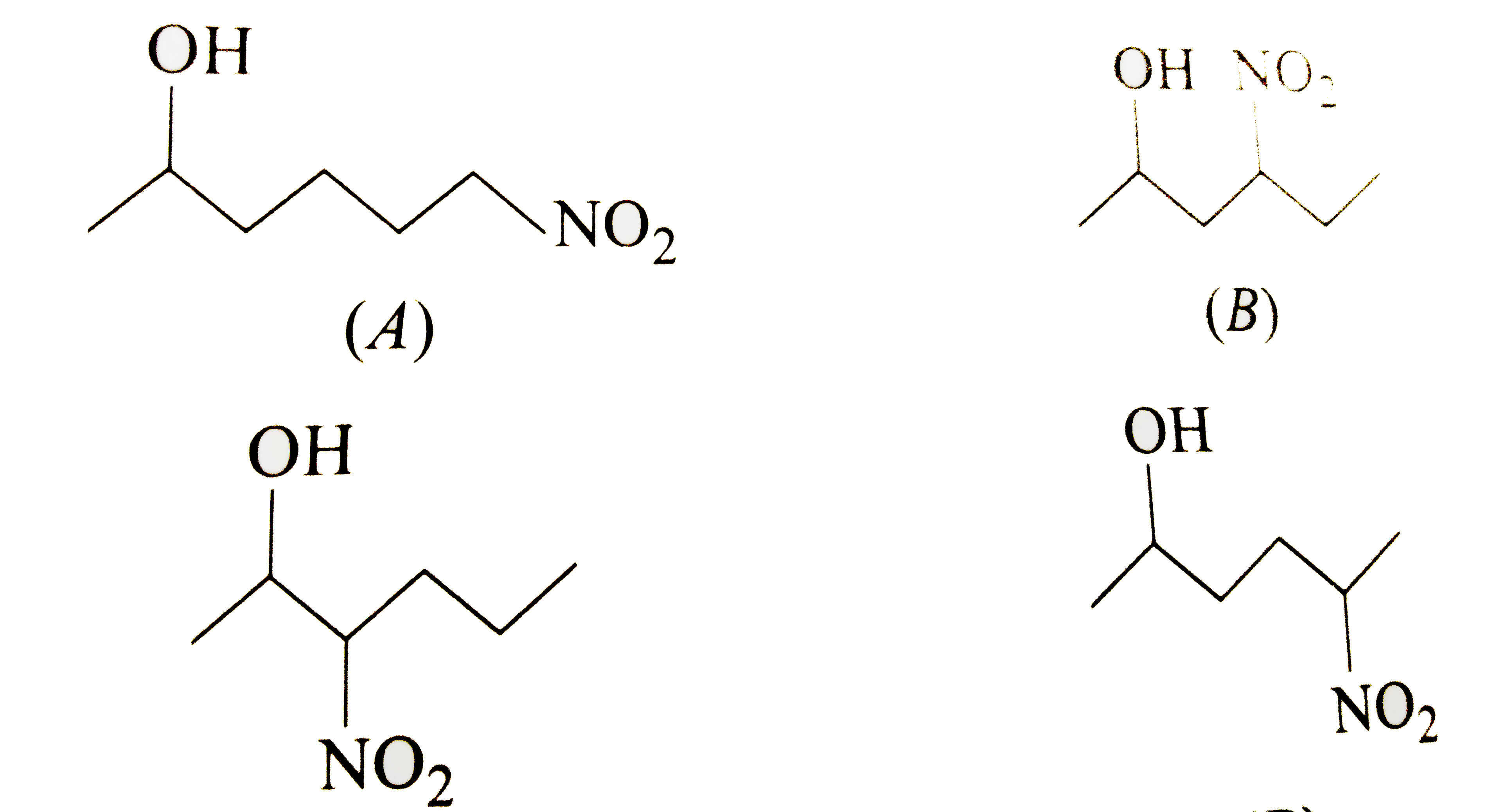Secondary and tertiary alcohols always give E1 reaction in dehydration. Primary alcohols whose β− carbon is 3∘or 4∘ also give E1 reaction. However, the primary alcohols whose β−carbon is 1∘ or 2∘ give E2 reaction. Dehydrating agents like conc. H2SO4,Al2O3, anhydrous ZnCl2 are used.
The reactivity of alcohols for elimination reaction lies in following sequence :
Tertiary alcohol > secondary alcohol > primary alcohol
Electron attracting group present in alcohols increase the reactivity for dehydration. Greater is the −I effect of the group present in alcohol, more will be its reactivity. Both E1 and E2 mechanism give the product according to Satzeff's rule, i.e., major product is the most substituted alkene.
CH3−C∣CH3H−OH∣CH−CH3conc.H2SO4−−−−−−−−−→above 413K3-Methylbutan-2-ol
CH3−C∣CH3=CH−CH32-Methylbut-2-ene(major product)+CH3−C∣CH3H−CH=CH23-Methylbut-1-ene(minor product)
Which among the following sequences of reactivity for dehydration is incorrect ?

CH3CH2CH2CH2OH<CH3−C∣OHH−CH2−CH3<CH3−CH3∣C∣CH3−OH


The correct Answer is:C
Topper's Solved these Questions
- ALCOHOLS, PHENOLS AND ETHERSBOOK - OP TANDONCHAPTER - ALCOHOLS, PHENOLS AND ETHERSEXERCISE - Passage 3
5 Videos
- ALCOHOLS, PHENOLS AND ETHERSBOOK - OP TANDONCHAPTER - ALCOHOLS, PHENOLS AND ETHERSEXERCISE - Passage 4
5 Videos
- ALCOHOLS, PHENOLS AND ETHERSBOOK - OP TANDONCHAPTER - ALCOHOLS, PHENOLS AND ETHERSEXERCISE - LINKED COMPREHENSION Passage 1
5 Videos
- ALDEHYDES AND KETONES BOOK - OP TANDONCHAPTER - ALDEHYDES AND KETONES EXERCISE - SINGLE INTEGER ANSWER TYPE QUESTIONS
10 Videos
Similar Questions
Knowledge Check
Secondary and tertiary alcohols always give E1 reaction in dehydration. Primary alcohols whose β− carbon is 3∘or 4∘ also give E1 reaction. However, the primary alcohols whose β−carbon is 1∘ or 2∘ give E2 reaction. Dehydrating agents like conc. H2SO4,Al2O3, anhydrous ZnCl2 are used.
The reactivity of alcohols for elimination reaction lies in following sequence :
Tertiary alcohol > secondary alcohol > primary alcohol
Electron attracting group present in alcohols increase the reactivity for dehydration. Greater is the −I effect of the group present in alcohol, more will be its reactivity. Both E1 and E2 mechanism give the product according to Satzeff's rule, i.e., major product is the most substituted alkene.
CH3−C∣CH3H−OH∣CH−CH3conc.H2SO4−−−−−−−−−→above 413K3-Methylbutan-2-ol
CH3−C∣CH3=CH−CH32-Methylbut-2-ene(major product)+CH3−C∣CH3H−CH=CH23-Methylbut-1-ene(minor product)
Which among the following alcohol will be the most reactive for dehydration ?ACH3OH∣CH−CH2−NO2BCH3−OH∣CH−CH2−CHOCCH3−OH∣CH−CH2−CNDCH3−OH∣CH−CH2−O∣∣C−CH3Secondary and tertiary alcohols always give E1 reaction in dehydration. Primary alcohols whose β− carbon is 3∘or 4∘ also give E1 reaction. However, the primary alcohols whose β−carbon is 1∘ or 2∘ give E2 reaction. Dehydrating agents like conc. H2SO4,Al2O3, anhydrous ZnCl2 are used.
The reactivity of alcohols for elimination reaction lies in following sequence :
Tertiary alcohol > secondary alcohol > primary alcohol
Electron attracting group present in alcohols increase the reactivity for dehydration. Greater is the −I effect of the group present in alcohol, more will be its reactivity. Both E1 and E2 mechanism give the product according to Satzeff's rule, i.e., major product is the most substituted alkene.
CH3−C∣CH3H−OH∣CH−CH3conc.H2SO4−−−−−−−−−→above 413K3-Methylbutan-2-ol
CH3−C∣CH3=CH−CH32-Methylbut-2-ene(major product)+CH3−C∣CH3H−CH=CH23-Methylbut-1-ene(minor product)
Which of the following dehydration products is incorrect ?A BCH3−CH3∣C∣CH3−OH∣CH−CH3conc.H2SO4−−−−−−→CH3−CH3∣C∣CH3−CH=CH2CCH3CH2CH2CH2OHconc.H2SO4−−−−−−→CH3−CH=CH−CH3D
BCH3−CH3∣C∣CH3−OH∣CH−CH3conc.H2SO4−−−−−−→CH3−CH3∣C∣CH3−CH=CH2CCH3CH2CH2CH2OHconc.H2SO4−−−−−−→CH3−CH=CH−CH3D
Secondary and tertiary alcohols always give E1 reaction in dehydration. Primary alcohols whose β− carbon is 3∘or 4∘ also give E1 reaction. However, the primary alcohols whose β−carbon is 1∘ or 2∘ give E2 reaction. Dehydrating agents like conc. H2SO4,Al2O3, anhydrous ZnCl2 are used.
The reactivity of alcohols for elimination reaction lies in following sequence :
Tertiary alcohol > secondary alcohol > primary alcohol
Electron attracting group present in alcohols increase the reactivity for dehydration. Greater is the −I effect of the group present in alcohol, more will be its reactivity. Both E1 and E2 mechanism give the product according to Satzeff's rule, i.e., major product is the most substituted alkene.
CH3−C∣CH3H−OH∣CH−CH3conc.H2SO4−−−−−−−−−→above 413K3-Methylbutan-2-ol
CH3−C∣CH3=CH−CH32-Methylbut-2-ene(major product)+CH3−C∣CH3H−CH=CH23-Methylbut-1-ene(minor product)
Arrange the reactivity of given four alcohols in decreasing order for dehydration .
 AA gtBgtCgtDBDgtCgtBgtACCgtBgtDgtADBgtCgtAgtD
AA gtBgtCgtDBDgtCgtBgtACCgtBgtDgtADBgtCgtAgtD
Secondary and tertiary alcohols always give E1 reaction in dehydration. Primary alcohols whose β− carbon is 3∘or 4∘ also give E1 reaction. However, the primary alcohols whose β−carbon is 1∘ or 2∘ give E2 reaction. Dehydrating agents like conc. H2SO4,Al2O3, anhydrous ZnCl2 are used.
The reactivity of alcohols for elimination reaction lies in following sequence :
Tertiary alcohol > secondary alcohol > primary alcohol
Electron attracting group present in alcohols increase the reactivity for dehydration. Greater is the −I effect of the group present in alcohol, more will be its reactivity. Both E1 and E2 mechanism give the product according to Satzeff's rule, i.e., major product is the most substituted alkene.
CH3−C∣CH3H−OH∣CH−CH3conc.H2SO4−−−−−−−−−→above 413K3-Methylbutan-2-ol
CH3−C∣CH3=CH−CH32-Methylbut-2-ene(major product)+CH3−C∣CH3H−CH=CH23-Methylbut-1-ene(minor product)
In the reaction, CH3−CH3∣C∣CH3−CH2OHconc.H2SO4−−−−−−→ the product (s) obtained will be :
View SolutionPrimary alcohols on dehydration give
View SolutionPrimary alcohols on dehydration give
View SolutionPrimary, secondary and tertiary alcohols are distinguished by
View SolutionDehydration of methyl alcohol with conc. H2SO4 yields
View Solution
